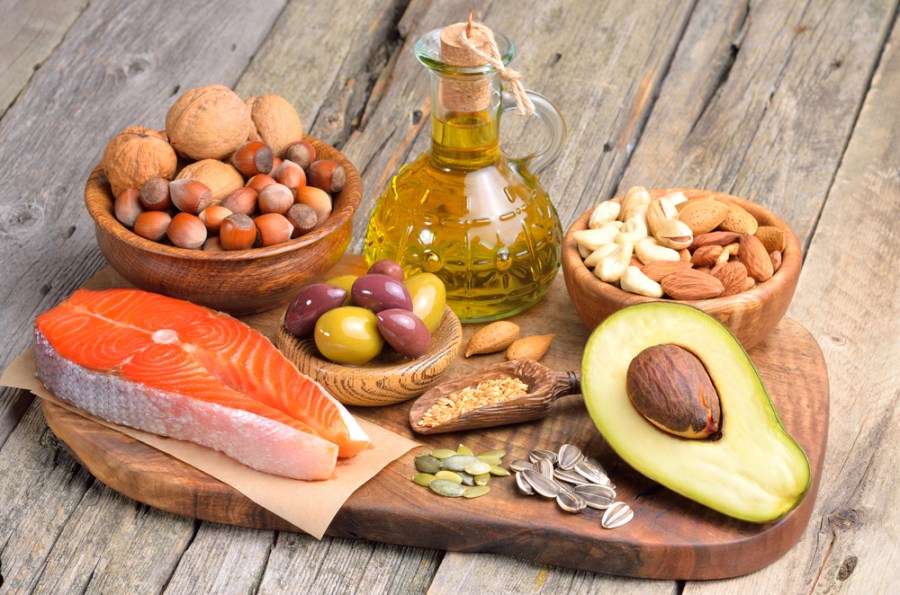Confused about whether to include fats in your diet when you want to lose weight? Nutritionist Angela Dowden explains the difference between the good and bad fats in food.
If you’re still feel a bit flummoxed by dietary fat, it’s hardly surprising. After years of being pushed ‘healthy’ low fat foods by the food industry, we were getting used to the idea that there are good and bad fats. Then along came a new batch of headlines suggesting that ‘butter is back’ and that we should pour coconut oil over everything.
It’s a confusing scenario that frustrates most qualified nutrition professionals. ‘Research is evolving all the time, but the consensus on fats and health hasn’t changed much in a while,’ says registered dietitian Helen Bond. ‘There are plenty of new theories getting air time that sound cutting edge and exciting, but they are usually not based in science.’
So, what’s the truth on fat and how it should it be included in a healthy, calorie-controlled diet? Buckle up for our whistle stop, but comprehensive, tour.
Fat can be good and bad
The bottom line is that too much fat of any kind isn’t great, as with nine calories per gram it’s the most calorific nutrient. Official recommendations are that around a third (35 per cent) of our calories should come from fat, which translates into 70g fat a day for women eating 2000 calories (or in vegetable oil terms, just over 5 tablespoons). For men on an average 2500 calories, the figure works out as no more that 95g fat a day (just over 7 tablespoons of oil).
General tips for cutting down include buying leaner cuts of meat, grilling rather than frying, and measuring oil with a spoon rather than just pouring it over your food. Cutting fat too drastically isn’t a good idea. Some fat is vital for functions, such as insulating internal organs and providing fat-soluble vitamins (A, D, E and K). The World Health Organization suggests we get a minimum of 20 per cent of our calories from fat, which means even if we are slimming down – i.e. only eating 1500 calories a day in order to lose weight – we should still not go below around 33g fat a day (that’s about 2 ½ tablespoons).
However, what’s even more important than the total amount of fat in your diet is the type of fats it contains. Some healthy diets, like the Mediterranean diet, can typically contain up to 40 per cent of energy from fat (more than is recommended in the UK). However, it is still very healthy because it’s higher in the good fats and lower in the type that aren’t so great.
Red coding: Cut down on saturates
Found in…
Fatty meats, pate and sausages, cheese, butter and lard, cream and full fat milk, pastry, cakes and biscuits, chocolate, creamy sauces, palm oil, coconut oil.
How much saturated fat should we eat every day?
Women are recommended to have no more than 20g saturated fat daily (men no more than 35g), but on average we’re eating around 13.5 per cent more than recommended. 20g of saturated fat is the amount in just 37g of butter (less than 4 of those little butter trays you get at hotel breakfast), or a 23g (a heaped tbsp) of coconut oil or one a half Cornish pasty. A top tip when you’re looking at labels is to check the “saturates” content per 100g; more than 5g per 100g is a lot and less than 1.5g per 100g is a little
What’s the story?
Saturated fats are the type found largely, but not exclusively, in animal products. This type tends to be solid at room temperature, and eating too many can increase blood cholesterol levels, which in turn can lead to furred arteries and increased heart disease risk. But what you swap saturated fat with also matters – research shows that replacing the calories from saturated fat with refined carbohydrates does not lower heart disease risk but replacing them with unsaturated fats does.
Recent research also now seems to point to some types of foods rich in saturated not being as bad as others. For example, studies show people who eat a lot of full fat dairy products don’t have a higher risk of heart disease, while the saturated fats in coca butte (dark cholate) and coconut oil are also arguably not particularly harmful.
Amber coding: Eat in moderation – Monounsaturates
Found in…
Olive oil, rapeseed oil, groundnut oil, avocadoes, nuts (especially hazelnuts, pecans and macadamias); also, in crisps and savoury snacks, and processed products fried in rapeseed or high oleic sunflower oil.
How much monounsaturated fat should we eat every day?
The recommendation is that around 12 per cent of our daily calories should come from monounsaturated fats – that’s 26g for someone eating 2000 calories. This is the amount in 3 tablespoons of olive oil. Dietary surveys like the National Diet and Nutrition Survey shows that most of us eat about the right amount of monounsaturates but it can’t hurt to eat more.
What’s the story?
Monounsaturates rate high in the health stakes because they help lower total blood cholesterol, whilst increasing the proportion of HDL (“good”) cholesterol. Because they are more chemically stable than polyunsaturates, they are also much less susceptible to harmful oxidation and more stable to heat, which means they are less liable to degrade and form cancer-promoting products in the body and when heated. This makes olive or rapeseed oil a good choice for your stir fry.
Eat in moderation: Omega-6 Polyunsaturates
Found in…
Sunflower oil, corn oil, and products made with these oils (like oven chips, crisps etc.), chicken with skin and breaded poultry products, nuts and seeds (especially pine nuts, sunflower seeds, walnuts).
How much fat should we eat every day?
It’s recommended that approximately six per cent of our energy should come from these fats (that’s approximately 13 g a day for someone consuming 2000 calories). That’s the amount in 1 ½ tablespoons.
What’s the story?
The main health benefits of these fats are the are healthy is that they supply essential fatty acids (EFAs) that can’t be manufactured by our bodies. EFAs help maintain cell structure, lock in the skin’s moisture and are required in the production of hormone-like substances called prostaglandins that regulate the menstrual cycle, reproduction, sex drive and blood pressure.
Like monounsaturated, omega-6 polyunsaturated also help lower your cholesterol levels, reducing your risk of heart disease. But we already tend to eat enough as they crop up in many processed foods. Very high intakes aren’t advisable as these delicate fats can oxidise (go “rancid”) in the body, which might promote conditions like cancer, asthma and arthritis.
Green coding: Eat more Omega-3 Polyunsaturates
Found in…
Oily fish like salmon, sardines, mackerel (canned or fresh) and tuna (fresh only); seeds and nuts (especially linseeds and walnuts), omega-3 fortified eggs, flax, walnut and rapeseed oils, leafy green vegetables such as kale.
One recommendation is that we get 1g a day of an omega-3 fat called alpha linolenic acid, which can contribute to lowered cholesterol. The second recommendation relates to combined intake of the longer chain omega-3s EPA and DHA. Fortunately making sure that you eat 1-2 140g portions of oily fish is an easy way to guarantee you’re getting a useful amount. If you don’t eat fish, you’ll need to eat several of the other sources listed above every day.
What’s the story?
Omega-3s are a type of polyunsaturated fat that is very beneficial, and most of us eat too few. Omega-3s have important anti-inflammatory and anti-clotting properties, which might make us less prone to conditions such as heart attacks, asthma, eczema, and possibly cancer. They’re important in pregnancy for the baby’s brain too.
What are trans fats?
The worst type of dietary fat is the kind known as trans-fat (found in cakes, pies, cookies, biscuits and pastries). It’s a byproduct of a process called hydrogenation that’s used to turn healthy oils into solids and prevent them from becoming rancid. The problem with trans fats is that they have a different chemical stricture to the natural ‘cis’ fats and can’t be used by the bod for any biological functions – they just end up being stored in our body fat. They are linked with heart disease and there’s no safe level of consumption. The good news? Most supermarkets and the bigger fast food chains have signed up to a voluntary agreement not to use artificial trans fats and we consume on average much less that the level that’s regarded as a safe maximum (two per cent of overall energy intake). But you could still have too many trans-fats if you eat a lot of takeaways and fried foods like fish and chips, Chinese meals, or pastries and doughnuts. It’s just one other reason to minimise intake of these foods that are bad for the waistline any way.







